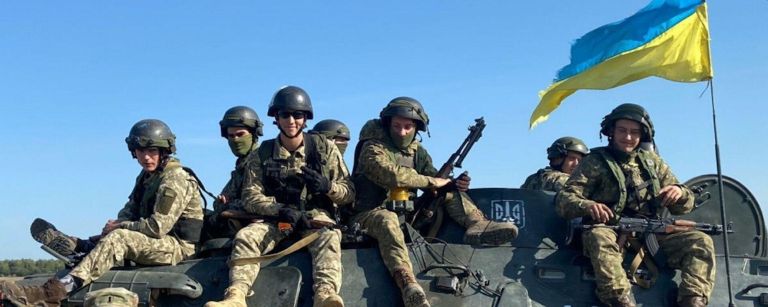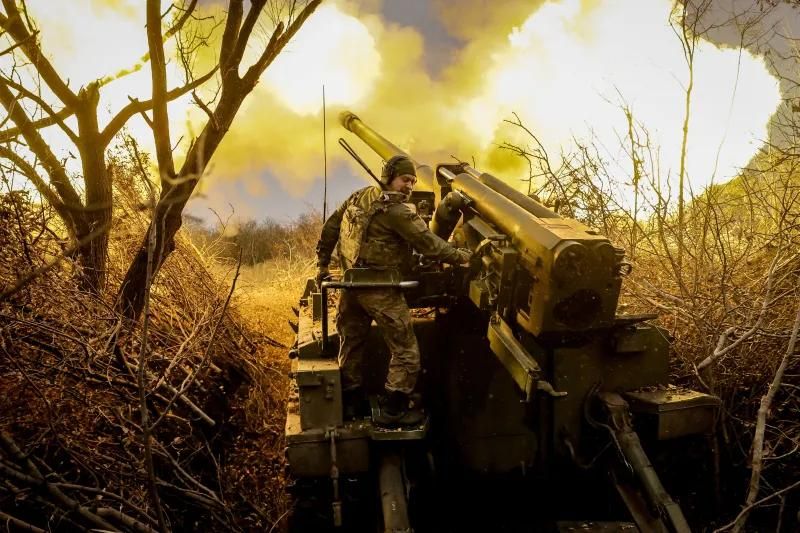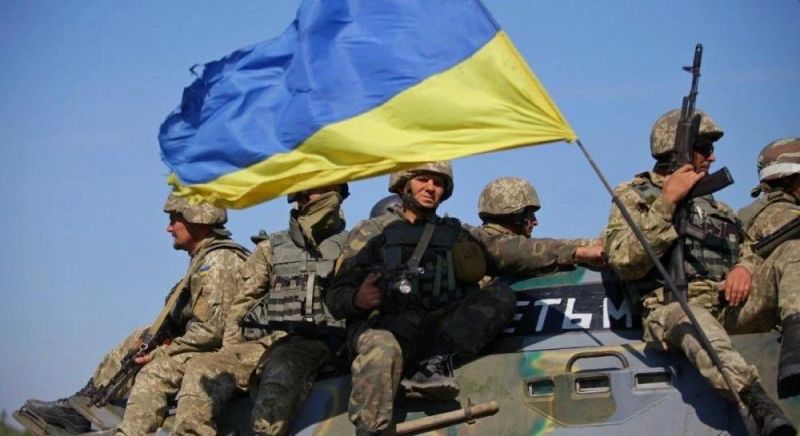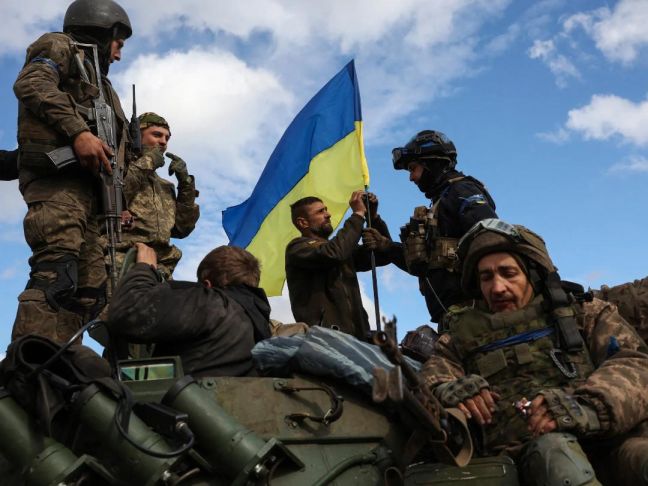By Eric Vandenbroeck and co-workers
Convince Kyiv to Trade Land for NATO
Membership
At a CNN town hall in
May 2023, Donald Trump promised that if elected, he would end the war in Ukraine
in a single day. That bullish pledge has now become a familiar refrain, with
the president-elect insisting that he uniquely has the nous to bring Russia and
Ukraine to the table and force a truce. His imminent return to the White House
has stirred a great deal of speculation on both sides of the Atlantic about the
prospects for a peace deal. Since Russia launched its full-scale invasion in
2022, Kyiv and its backers have been wary of signaling an interest in
negotiations, fearful that doing so would be seen as a weakness. Trump’s
reelection now gives Ukrainian President Volodymyr Zelensky greater freedom to
engage in talks: he can argue that he has no choice. In late November, in an
interview with Sky News, he suggested that he was indeed ready to negotiate.
In
Ukraine Conditions on the ground, however, are not conducive to a
deal. Wars usually end in two ways: one side wins, or there is a stalemate. In
Ukraine, neither side seems near victory, but the war has not yet ground to a
standstill. Russian President Vladimir Putin thinks he is winning. If Trump
threatens to cut aid to Ukraine, Putin will be even more emboldened to keep
fighting, not end his invasion; advancing
armies rarely stop fighting when their opponent is about to become weaker.
If Putin senses that Trump and his new team are trying to appease the Kremlin,
he will become more aggressive, not less.
The lessons from U.S.
negotiations with the Taliban during Trump’s first term should inform the
president-elect’s thinking about dealing with Putin. The Taliban and the Trump
administration negotiated a deal that was highly favorable to the militant group
but that the Biden administration nevertheless honored. Its terms included a
cease-fire, a timeline for the departure of American forces, and the promise of
a future political settlement between the Afghan government and the Taliban.
The Taliban, however, did not commit to the agreement; instead, they used that
peace plan as a weigh station on their path to total victory. Appeasement of
the Taliban did not create peace. Appeasement of Putin won’t either. Instead of
just giving Putin everything he wants—hardly an example of the
president-elect’s much-vaunted prowess in dealmaking—Trump should devise a more
sophisticated plan, encouraging Ukraine to nominally relinquish some territory
to Russia in exchange for the security that would come with
joining NATO. Only such a compromise will produce a
permanent peace.

The Trump Card
In their rhetoric,
Trump and many of his allies have long expressed skepticism about U.S. support
for Ukraine. They claim that backing Kyiv is a drain on American finances and
has done little to end the war. But to abruptly cut funding for Ukraine now would
not bring about peace; it would only spur further Russian aggression. To work
toward a peace deal, Trump should first accelerate the delivery of military aid
to Ukraine that has already been approved and then signal his intention to
provide more weapons to stop Russia’s current offensive in Donbas, the
much-contested eastern region of Ukraine, and thereby create a stalemate on the
battlefield. Putin will only negotiate seriously when Russian armed forces no
longer have the capacity to seize more Ukrainian territory—or better yet,
though less probable when Russian soldiers begin losing ground. For serious
negotiations to begin, Putin must first believe that the United States will not
abandon Ukraine.

After he convinces
Putin to negotiate, Trump must also persuade Zelensky to stop fighting. That
will be a significant challenge, as doing so will require the Ukrainian
president to give up the quest to liberate all Ukrainian territories occupied
by Russian soldiers. In giving up land, Zelensky would also have to abandon his
citizens in those occupied regions or find a way to guarantee that they would
be allowed to emigrate to western Ukraine. No democratically-elected
leader makes such a concession lightly. A poll conducted this fall showed that
88 percent of Ukrainians still believe that Ukraine will win the war. Ukrainian
soldiers, many of whom now fight to avenge their comrades killed in combat,
will find it very difficult to lay down their weapons.

Zelensky and the Ukrainian people will not make such a
sacrifice without receiving something of value in return: NATO membership.
Gaining immediate entry into NATO would help offset the bitter concession of
allowing a giant chunk of their country to remain under Russian occupation. It
is the one card Trump can play to convince Ukrainians to stop fighting.
Ukraine’s membership
in NATO is also the only way to maintain permanent peace along the border
between Russia and Ukraine, wherever it is finally drawn. Lesser security
guarantees to Ukraine, such as the feckless 1994 Budapest Memorandum, in which
Russia, the United Kingdom, and the United States offered Ukraine security
assurances in exchange for Kyiv’s handing over its nuclear arsenal to Moscow,
or more recent proposals of support from individual countries are not credible.
Ukrainians know that Putin has never attacked a NATO member but invaded Georgia
in 2008, invaded Ukraine in 2014 and 2022, and keeps soldiers in Moldova. They
have witnessed how Russia signed and then violated multiple international
treaties and agreements prohibiting the use of force against Ukraine. Pieces of
paper do nothing to constrain Russian aggression. Ukrainians rightly worry that
a cease-fire in the absence of NATO membership will only give the Russian army
and Russia’s military-industrial complex time to gain strength and prepare for
a future invasion. That’s precisely what happened between 2014 and 2022. If
Ukrainians are going to acquiesce to what promises to be a long Russian
occupation of roughly a fifth of their country, they need the credible
deterrence that only NATO can offer.
In such a compromise,
the timing of NATO’s announcement that it is offering membership to Ukraine
will also matter a great deal. The alliance must issue the formal invitation
the day Zelensky and Putin agree to stop fighting. After NATO invites Ukraine to
join, member states must ratify the country’s accession quickly. Trump
personally must signal his unequivocal support so that other NATO leaders do
not drag out the ratification process. Right now, Trump has tremendous
political capital to wield over some of these potential holdouts, including
Hungarian Prime Minister Viktor Orban and Slovak Prime Minister Robert Fico. He
should use this leverage early in his presidency to secure a swift deal and
bring the dreadful war in Ukraine to an end.

Victory Day For All
Skeptics argue that
Putin will never accept Ukraine’s joining NATO. But Ukraine and NATO members do
not need to ask for Putin’s permission. Putin has no place in negotiations
between Ukraine and the alliance. Allowing him to disrupt or put off these deliberations
would be a sign of American weakness not only to Moscow but also to Beijing.
These skeptics also
grossly overestimate Putin’s concern about Ukraine’s joining NATO. Putin did
not invade Ukraine in 2022 to stop NATO’s expansion. In the run-up to 2022,
NATO membership for Ukraine was a distant dream, and everyone in Brussels,
Kyiv, Moscow, and Washington knew it. Putin’s invasion had other objectives: to
unite Ukrainians and Russians into one Slavic nation, overthrow Ukraine’s
democratic and Western-oriented government, and demilitarize the country. Putin
barely raised an eyebrow when Finland and Sweden joined NATO in 2023 and 2024,
even though Finland shares an 830-mile border with Russia. His war has driven
Ukraine ever closer to NATO, not pulled it away.
But if the Russians
insist that Ukraine’s joining the alliance threatens Russia—and they will—Trump
can explain to Putin that NATO membership will constrain Ukraine. Zelensky, of
course, will never formally recognize the Russian annexation of occupied Ukrainian
territory. Yet the possibility of NATO membership could lead him to agree to a
formula in which Kyiv accepts that it will only seek the reunification of
Ukraine through peaceful means. West Germany and South Korea agreed to similar
terms in return for defense treaties with NATO and the United States. As a
condition for joining the alliance, Zelensky and his generals could also be
obligated to withdraw Ukrainian soldiers from the Russian region of Kursk,
where they have maintained positions since August. NATO is a defensive
alliance. It has never attacked the Soviet Union or Russia, and it never will.
Putin knows that.
If appropriately
timed to happen when the war ends, the day that Ukraine is invited to join NATO
will also be the most glorious day in Putin’s career. He will be able to
proclaim to the Russian people and the world that his invasion was a success,
that he has “won.” He will hold a victory parade on Red Square with Chinese,
Iranian, and North Korean leaders at his side atop Lenin’s tomb. He will claim
a place in Russian history books next to Peter the Great, Catherine the Great,
and Stalin as a Kremlin leader who expanded the borders of the Russian empire.
On this alleged “victory day,” he will not want to spoil his triumph by
starting another war or threatening one to try to block Ukraine’s membership in
NATO.
Some politicians in
NATO countries, including Germany and Hungary, have expressed worries that
Ukraine’s admission to the alliance could trigger World War III. They argue
that because some of the country is in Russian hands, a wider war is inevitable
if Ukraine becomes a NATO member. This analysis is flawed. After three years of
painful war with Ukraine, Putin has no appetite to fight the most powerful
alliance in the world, anchored by the U.S. military, the world’s best. The
Russian army has endured tremendous losses while making only incremental gains
on the battlefield against an under-armed and undermanned Ukrainian foe. Putin
will not dare to go to war with the mighty U.S. armed forces and their allies
after some 78,000 Russian soldiers have been killed in Ukraine—a figure that,
according to some estimates, grows to between 400,000 and 600,000 when
including Russian soldiers wounded in the fighting. The Kremlin is scrambling
for manpower, and its military enterprises are struggling to replenish Russia’s
most sophisticated weapons because of ongoing sanctions.
German leaders, in particular, should understand the advantages of NATO
membership for a divided country. West Germany joined NATO in 1955. That act
did not spark World War III, even though West Berlin was surrounded by East
German territory. Just the opposite: NATO membership helped keep the peace. On
its own, West Germany might not have survived with the Soviet Red Army just
across the border in East Germany.
More broadly, Europe
would benefit economically from a stable and secure Ukraine. NATO allies would
no longer need to provide billions in economic assistance to Kyiv or care for
the millions of Ukrainian refugees straining welfare systems in European countries.
Just as NATO facilitated the economic development of Western Europe during the
Cold War, Ukraine’s membership in NATO would help the economies of all NATO allies benefit from trade with and investment in a booming
postwar Ukrainian economy. The U.S. economy would benefit, too, especially from
access to Ukraine’s critical minerals for advanced batteries and other vital
technologies, which could help reduce American dependence on more unreliable
autocratic suppliers.

Man in the Middle
Of course, one more
person needs to be convinced of the merits of this peace plan: Trump. Given his
past skepticism about aid to Ukraine and NATO more generally, it will not be
easy to persuade him to take this path. Such a deal, however, supports several
of Trump’s objectives. By bringing Ukraine into NATO, Trump could achieve a
significant victory for one of his foreign policy priorities: burden-sharing.
After joining NATO, Ukraine’s armed forces would overnight become the best and
most experienced European army in the alliance. Ukrainian soldiers could be
deployed to other frontline states, allowing Washington to reduce its own troop
commitments. Ukraine could also supply other NATO allies, especially those that
share a border with Russia, with the air, sea, and land drones that the
Ukrainian military has mastered in its defense of the country. Trump could
explain to the American people that Ukraine’s membership in NATO would allow
the United States to spend less on European defense and free up resources to
contain China’s growing influence in the Asia-Pacific region. Such a move
should win the support of the many China hawks in Trump’s new administration.
This plan would
prevent the kind of collapse and conquest that followed the U.S. withdrawal
from Afghanistan in 2021. It would also produce a lasting peace in Europe, not
a temporary cease-fire easily broken by Russia in the future. If Trump
succeeded in brokering this settlement, he could become a candidate for the
Nobel Peace Prize, an honor he covets.
The odds may be
stacked against such a plan. Neither Putin nor Zelensky will be easily coaxed
to the table, and Trump might resent the imperative of having to maintain, and
even expand, support for Ukraine as a means to force
negotiations. But an endless war or capitulation to
Putin would be far worse.
For updates click hompage here